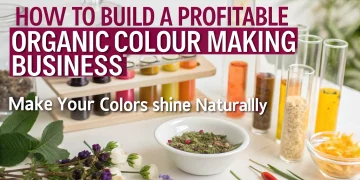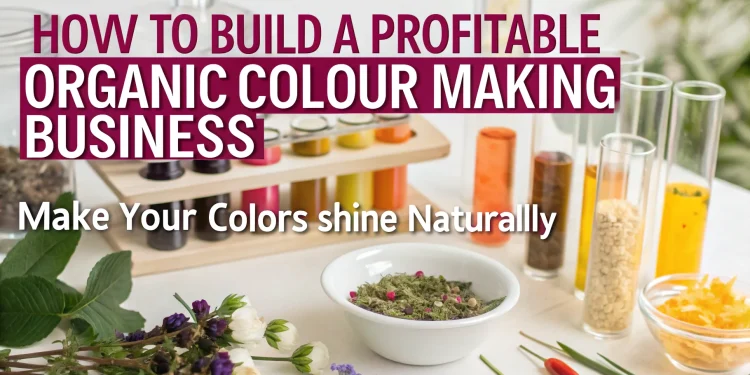Eco-friendly and health-conscious products are becoming more popular with consumers and the usage of Organic Colour Making and herbal colorants are growing in demand in almost every sector, ranging from food and beverages to cosmetics and even agriculture. India has an advantage because of its established Ayurvedic systems and the variety of botanicals in India, which can lead the way to using herbal colors.
If you are an entrepreneur and a new startup looking for a highly profitable and sustainable opportunity, the organic color making business is a good possibility. In this guide, we will explore a detailed overview of the market needs, potential growth, manufacturing process, regulatory certifications, and strategic tips to create a successful organic color business.
What are the Organic Color Advantages and Why are They Popular?
The synthetic chemicals and additives are easier to use than organic colors, which gives room for natural pigments to flourish. Organic colors are eco-friendly as they are produced from natural sources, and herbal plants like turmeric, indigo, sandalwood, and beetroot. Organic colors are biodegradable, non-toxic, and have additional benefits as they have medicinal properties.
In several industries, including food processing, cosmetics, and eco-friendly textiles, brands are being compelled by consumers and regulations alike to adopt more natural alternatives. This makes organic colors more of a world-wide shift, rather than a trend, in product development.
Related: Top 18 Industrial Business Ideas for Startups and Entrepreneurs
Industry Demand and Market Overview
There are tremendous opportunities in the global natural colorants market. In line with other industry projections, the natural food colors segment was valued at more than USD 3.5 billion in 2024, with an expected rise to USD 5.2 billion by 2030. The CAGR is expected to stabilize at around 6.5% with India playing a major role in both consumption and exports.
India’s small and medium-sized enterprises (SMEs) are exporting products such as eco-friendly Holi colors, Ayurvedic herbal dyes, and food-safe pigments to the United States, Germany, the United Kingdom, and Australia, which are established organic markets.
What is fascinating is the broad market, including cosmetics, textiles, handicrafts, and processed food, which also constitute a bulk consumer market, are currently buying organic colors from designated vendors in bulk, which creates B2B chances for budding businesses looking to grow.
Factors like awareness of clean labels, government bans on synthetic dyes, the growth of vegan and cruelty-free products, and the rise of Ayurveda-based wellness products all promote a steady and sustainable demand in this sector.
Types of Organic Colour Making and Industry Use Cases
Certain plant or mineral elements can be preferentially used to different sectors based on the colours they impart. For example, turmeric and beetroot find application in the food and festive colours sectors, while henna and indigo serve hair care and textiles.
Turmeric has a bright yellow colour and is used in the preparation of pickles and snacks. Natural blue colour for fabrics can be obtained from indigo leaves. Marigold petals yield rich orange colours, which are used in cosmetics. Food-safe red of beetroot is used in juices and bakery items. These raw materials are available in India in abundance, and their traditional importance adds to the market value.
Whether the target is Ayurveda cosmetics, clean label packaged food, or seasonal colours, it is essential to know the target industry to understand what colourants should be manufactured.
View our Handbooks on Food Additives, Food Colours, Colors, Flavours
How Organic Colours Are Made: A Process Overview
The processes for obtaining organic colour making are slightly different depending on the raw material, but all are aimed at extracting, purifying, and stabilizing the dye, and so the general methodology is the same.
Obtaining pesticide-free foliates, roots, flowers, or seeds constitutes raw materials that are of the highest quality for a specific process. Soil, dust, or other contaminants are cleaned away thoroughly, while, in most instances, the materials are dried and ground, which increases surface area and enhances pigment extraction.
Extraction, which usually involves water or food-grade solvents like ethanol, is followed. Some newer systems make use of ultrasonic extraction, while others use enzymatic pretreatment for better yield or consistency. Filtered and concentrated extracts are enriched with pigments and then filtered and concentrated using ethanol.
The ethanol extract is then filtered, concentrated, and spray dried or freeze dried to transform it to a usable/workable substance. The end pigment is then standard blended to adjust for consistency, by setting it in containers that are sealed and moisture proof to bolster shelf life. The pigment is then stored safely to stand the tests of shelf life, temperature, and location.
Stringent testing and food safety procedures must be followed for hygiene food-grade, or cosmetics grade applications to ensure that safety and international standards are met.
Related: Starting a Vedic Paint Manufacturing Business
How to Overcome Key Challenges
The specific pigments can be of lower grade due to exposure to heat or light, followed by the issue that seasonal cycles may limit the synthesis. Synthetic dyes are more reliable and steadier in achieving quality. The above makes it all the more challenging because standardization techniques cannot be employed to retain quality.
To tackle these problems, entrepreneurs need to set up basic quality control systems and think about collaborating with agricultural universities or research laboratories focusing on natural products. There is also a need to invest in vacuum and encapsulation dryers to improve product stability and prevent spoilage.
Similarly, working with farmer groups or certified organic farms to obtain a consistent and local supply of raw materials helps mitigate input volatility and establish supply chain traceability, which is important for export markets.
Legal Requirements and Certification Standards
Since the product is used for application on the skin, food, or cosmetic application, compliance and certification is necessary. For businesses based in India, the FSSAI licensing is a must for food-grade colours. Cosmetic-grade colours are regulated under the Drugs and Cosmetics Act.
For export markets, USDA Organic, India Organic, ECOCERT, COSMOS, and ISO/GMP certifications are essential. If the product is targeted towards religious and traditional communities, the product will need to obtain Halal or Kosher certifications.
Gaining compliance ensures customer loyalty and access to global high-margin buyers.
Business Models and Market Entry Strategies
There are multiple options to enter the organic colour sector depending on your business objectives.
A small-scale artisanal unit can serve local wellness shops, eco-friendly fairs, or farmers’ markets. This work might be intensive, but it allows deep brand connection and storytelling.
On a bit larger scale, businesses can specialize as B2B raw material suppliers to herbal cosmetic brands, Ayurveda wellness manufacturers, and clean-label food processors. This strategy demands more investment on product quality control and consistency.
A third option is to act as a contract manufacturer for startups that want to launch brands under their labels. This strategy lets you capitalize on production while your clients manage brand and marketing.
Meeting international standards and obtaining necessary certifications can prepare you for export-led models, as long as the documentation matches the standards of the buyers.
Marketing and Brand Positioning Tips
Building credible and identifiable organic color brands comes from more than production quality. Differentiation in a saturating market stems from quality storytelling, customer education, and packaging.
With your product’s values in mind, opt for eco-friendly, recyclable, or biodegradable packaging. Winning consumer trust is easier with transparent ingredient sourcing, processing, and certifications.
For B2B companies, having an online presence is a must. Detailed product and company websites, product and company videos, testimonials, and presence on platforms like IndiaMART, Amazon Business, or Alibaba connect you to wholesale buyers globally.
You can teach the market using blogs or YouTube videos that explain the extraction process, the farmers’ partnerships, and the uses during the festivals. Premium buyers are especially responsive to the business’s give and take traditions, as well as to traceability and historical practices.
Technology and Innovation in Organic Pigments
The organic color industry is adopting new technology. Startups are experimenting with bio-fermentation to cultivate high-yield pigment strains that are not seasonally dependent. Some others are focusing on the stability of processed foods or sunscreens using encapsulation.
There is also hybrid extraction technology that uses heat, ultrasonics, and enzyme-assisted extraction, which uses less energy and results in higher yields. Adopting such technologies could expand the range of applications for your products and greatly improve your competitive standing.
Food and cosmetics industries often deal in bulk, and so, with the right R&D, pigment derivatives can easily be created to suit their specifications.
For more information, check out this video on this related article
How NIIR Project Consultancy Services (NPCS) Supports Entrepreneurs
Starting a manufacturing business can be daunting without expert guidance. NIIR Project Consultancy Services (NPCS) provides entrepreneurs with Market Survey cum Detailed Techno Economic Feasibility Reports tailored to their business needs.
These reports include practical information such as manufacturing processes, raw material requirements, plant layouts, and financials, helping you make informed decisions.
With a track record of helping hundreds of businesses launch successfully, NPCS acts as a knowledge partner for those entering the industrial, food, or natural product sectors, especially in emerging green businesses like organic colour manufacturing.
Find Best Idea for Yourself With our Startup Selector Tool
Final Thoughts
The shift from synthetic to organic colourants is no longer limited to niche markets—it’s a mainstream transition driven by legislation, health awareness, and global sustainability goals. With the right approach to sourcing, manufacturing, and branding, entrepreneurs can build high-margin, purpose-driven businesses that thrive both domestically and in global markets.
India’s deep heritage in botanical sciences, coupled with access to low-cost, organic raw materials, makes it an ideal location to launch this kind of venture. Whether you’re targeting the food industry, natural cosmetics, sustainable fashion, or export markets, there’s room for innovation, growth, and long-term profitability.
For startups ready to take a step into green manufacturing, organic colour production offers a powerful mix of tradition, innovation, and opportunity.


















